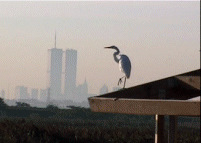As a visual presence, athe Twin Towers belonged as much to New Jersey as New York. Here, in fact, we had the best view of them. Certainly better than Manhattan, where other buildings often blocked the way, and tourists on the towers’ giant plaza had to crane their necks back just to get a foreshortened perspective.

But, from this side of the Hudson, you saw the 110-story near-twins the way they were meant to be seen, the way they must have looked in idealized model form, back in the Sixties, when the project was in its infancy.
You needed distance to get the full effect, and North Jersey provided that, not just with its stunning waterfront views from Hoboken and Jersey City, but from countless locations all over the region. Because of the broad, low-lying Meadowlands in the city’s foreground, hundreds of thousands of people had daily, unimpeded views.
And, when you traveled about, they always seemed to be popping up from new angles. The Record building in Hackensack is worlds apart from Wall Street, but those towers were clearly visible from its southeast windows. I watched them rise story by story from the quiet Nutley neighborhood where I grew up. They were visible from Newark Airport, Sandy Hook, Garret Mountain, the Watchung Mountains, and countless places in between.
They were visual anchors, beacons, direction finders, and location fixers. Driving north on the turnpike on a clear day, you might suddenly catch sight of them, bigger and closer than your mind’s eye expected them to be. On a steamy night, they loomed mirage-like above the vast fields of phragmites.
At sunset, they were mirrors to the setting sun, sometimes glowing such a fiery orange that people in office buildings would stop work, and go to the windows to gaze.
The architect of the World Trade Center was Minoru Yamasaki, an American of Japanese descent. His assignment – to create 12 million square feet of floor area on a 16-acre site – demanded something very tall. At the time, architecture was under the sway of the clean, pure lines of the International Style.
But when the buildings were completed in 1973 – just about the time that architecture criticism was coming into vogue – they were panned by many. Urban critics complained about their bloated size, their disconnection from everything around them, and their banal shape. Two tall boxes! Modernism at its worst!
They took over the southern skyline. They dwarfed and bullied their neighbors, including the Gothic-styled Woolworth Building, with its gracefully rising tower and elegant crown. The trade center, by contrast, had no taper, no setbacks, and no crown at all. Just sheer sides and flat tops.
The critics had a point, but they underestimated some of its design strength, as well, specifically the power of two mirror-image forms. A single boxy building might have, in fact, been banal. But, two 110-story buildings seemed to play against each other, like an elegant matched set. Their lattice-like steel skin gave off a prismatic glitter in daylight and a shimmering luminosity at night.
The complaint about its stark verticality amid so many low-lying buildings was remedied in the early Nineties by the construction of the World Financial Center. By now, post-modernism was the dominant style, and these buildings were erected on the Hudson waterfront with a variety of domed, pyramidal, and stepped tops. From New Jersey, the chunky, broad-based buildings formed a pleasing, irregular foundation for the soaring towers.
But these are design niceties. Fussy details.

Architecture is not just about style, nor about function. It’s also about symbolism. Buildings make statements about the civilization that produced them. There was a lot of New York boosterism, even arrogance in the World Trade Center towers. They were powerful symbols of American economic might. Even the unadorned appearance, the unyielding lines, said something about the bald nature of 21st century capitalism. Had they not been powerful architectural symbols, they wouldn’t have been targets.
But those of us who lived in their vast neighborhood, who experienced them as part of the landscape, saw something else as well. As twins, there was something fascinating, even endearing about them. And, standing as they did, near the tip of Manhattan Island, two massive uprights, they suggested a threshold, a gateway.
And, on the simplest level, they were there. And now they’re not.
September, 2001

